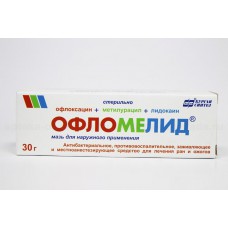Expiration date: 06/2026
Release form and composition:
Ointment for external use white or almost white.
1g contains:
ofloxacin 10 mg
dioxotetrahydrofuran (methyluracil) 40 mg
lidocaine hydrochloride (in the form of monohydrate) 30 mg
Excipients: methyl parahydroxybenzoate (nipagin or methylparaben), parahydroxybenzoate (nipazol or propylparaben), propylene glycol, macrogol-1500 (polyethylene glycol of low molecular weight polyethylene oxide 1500 and 1500), macrogol 400 (polyethylene glycol of low molecular weight of 400 and polyethylene oxide 400).
Pharmacological action:
Combined drug, has antimicrobial, anti-inflammatory, local anesthetic, regenerating effect.
Ofloxacin is a broad-spectrum antimicrobial agent from the fluoroquinolone group. It has a bactericidal effect due to the blockade of DNA gyrase in bacterial cells. Active against gram-negative and gram-positive microorganisms.
Methyluracil - a stimulator of tissue repair. It has anabolic activity. Accelerates cellular regeneration processes in wounds, accelerating tissue growth and granulation maturation and epithelialization.
Lidocaine has a local anesthetic effect due to the blockade of sodium channels, which prevents the generation of impulses in the endings of sensitive neurons and impulses on nerve fibers. With external use dilates blood vessels, does not have a local irritating effect.
The water-soluble basis of the ointment is a mixture of polyethylene oxides with a molecular weight of 400 and 1500, providing a dehydrating effect on the tissue, 20 times greater than the strength of 10% sodium chloride solution.
Pharmacokinetics:
Data on the pharmacokinetics of the drug Flamelet® is not available.
Indications:
Infected purulent wounds of different localization and etiology in the first (purulent-necrotic) phase of the wound process, including those accompanied by severe pain syndrome:
- infected II-IV degree burns
- bedsores
- trophic ulcer
- post-operative and post-traumatic wounds and fistulas
- wounds after opening abscesses, phlegmon, after surgical treatment of abscessed boils, carbuncles, hidradenitis, festering atheroma, lipoma.
Dosage regimen:
The drug is used externally, 1 time/day for 1-2 weeks. The maximum daily dose should not exceed 100 g of ointment. The duration of treatment depends on the dynamics of wound cleansing from purulent exudate and the timing of relief of the inflammatory process.
After the standard treatment of wounds and burns, the ointment is applied directly to the wound surface with a thin layer (after which a sterile gauze bandage is applied) or a gauze bandage with subsequent application to the lesion.
Tampons impregnated with ointment, loosely fill the cavity of purulent wounds after surgical treatment, as turundy gauze with ointment is introduced into the fistulous passages.
In the treatment of infected burns, the drug is used daily or 2-3 times a week, depending on the amount of purulent discharge.
Side effect:
Possible: allergic reactions.
Contraindications:
- pregnancy
- lactation
- child and adolescence to 18 years
- hypersensitivity to the drug components.
Pregnancy and lactation:
The drug is contraindicated in pregnancy and lactation (breastfeeding).
Overdose:
Data on overdose of the drug Flamelet® is not available.
Drug interaction:
There were no cases of interaction with drugs that would lead to a decrease in the effectiveness and safety of the drugs used.
Storage conditions and terms:
The drug should be stored out of reach of children, protected from light at a temperature of 15°C to 25°C.




